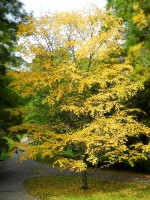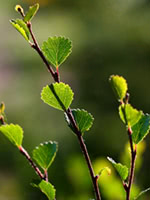Mon-Fri 9am - 5pm Mountain time
Bog Birch vs Sweet Birch (Black Birch)
Betula lenta
Betula pumila
NOT AVAILABLE THIS SEASON - MIGHT RETURN
NOT AVAILABLE THIS SEASON - MIGHT RETURN
Sweet Birch (Black Birch) is an attractive tree with a rounded shape native to eastern North America that would be a good addition to landscapes. It has a conical growth shape when young and as it ages the shape becomes more rounded. When the leaves, shoots, or bark are crushed they give off a sweet scent, which is what gives the Sweet Birch its name.
In early spring, the trees can be tapped and the sap used to produce syrup or fermented and made into birch beer. Pollinators and birds are attracted to the Sweet Birch as the pollen and seeds serve as a good food source. In the fall, the leaves turn golden yellow which will brighten your landscape.
The inner bark has a strong wintergreen scent and has been used to produce oil of wintergreen. Small twigs and bark of the tree can be boiled in water to make a tasty Sweet Birch tea.
Bog Birch is a hardy, deciduous shrub native to North America. It thrives in wetlands, riparian zones, and boreal forests, and can be found as far north as the Arctic Circle—making it one of the few woody plants to grow in such extreme climates.
In Western Canada, it is especially common in moist lowlands, along streambanks, and in peatlands. Beyond its ecological role in stabilizing soils and supporting wildlife, Bog Birch is frequently used in reclamation and restoration projects due to its resilience and ability to establish quickly in disturbed or degraded landscapes.
Note: We use Bog Birch for Betula pumila. This species is also known by many other common names, including Dwarf Birch, Swamp Birch, and others. Please confirm the scientific name to ensure you are ordering the correct plant.

